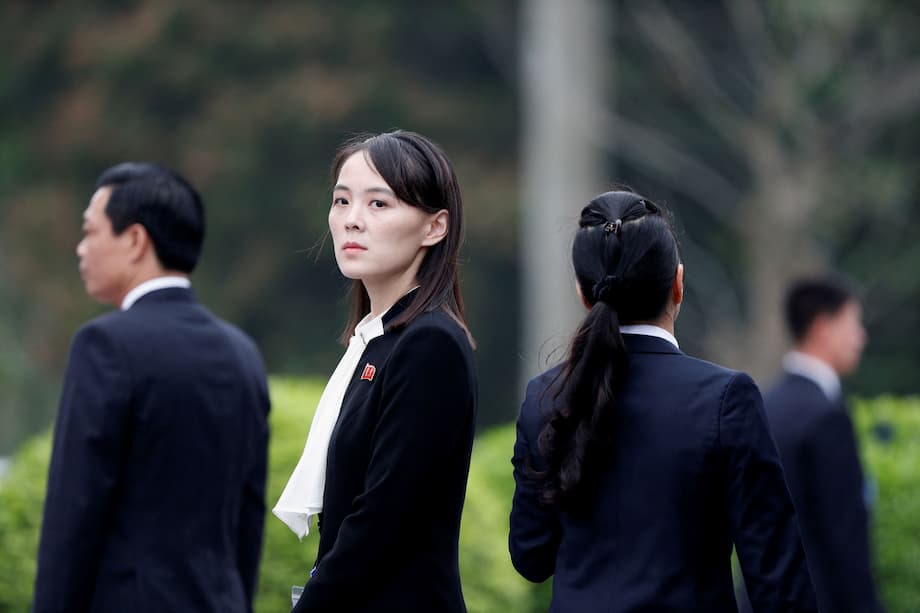North Korea’s Firm Rejection of South Korea’s Peace Initiatives
North Korea has delivered a stark rebuff to recent diplomatic overtures from South Korea’s new president, Lee Jae Myung, dashing hopes for a thaw in one of the world’s most entrenched geopolitical standoffs. In a statement released by state media on July 28, Kim Yo Jong, the influential sister of North Korean leader Kim Jong Un, declared that South Korea remains “the enemy” and that Pyongyang has “no interest” in talks, regardless of what proposals Seoul might offer. This pronouncement marks North Korea’s first official response to the new South Korean administration, which took office in June after a period of political upheaval in Seoul.
- North Korea’s Firm Rejection of South Korea’s Peace Initiatives
- Background: A History of Tension and Missed Opportunities
- South Korea’s New Approach Under President Lee Jae Myung
- North Korea’s Strategic Calculations: Russia, the U.S., and the Nuclear Issue
- South Korea’s Alliances and the Broader Geopolitical Context
- Public Sentiment and the Path Forward
- Expert Perspectives: The Limits of Diplomacy
- In Summary
President Lee’s government had moved quickly to signal a break from the hardline policies of his impeached predecessor, Yoon Suk Yeol, by suspending anti-North Korean loudspeaker broadcasts along the Demilitarized Zone (DMZ), halting the distribution of propaganda leaflets, and even considering the resumption of individual tours to North Korea. Yet, these gestures were dismissed by Kim Yo Jong as “not the work worthy of appreciation,” with North Korea insisting that the fundamental nature of inter-Korean relations has irreversibly changed.
Kim Yo Jong’s Statement: No Room for Dialogue
Kim Yo Jong’s remarks, carried by the Korean Central News Agency (KCNA), were unequivocal:
“No matter what policy is adopted and whatever proposal is made in Seoul, we have no interest in it and there is neither the reason to meet nor the issue to be discussed with the ROK [Republic of Korea].”
She further accused the new Lee administration of “blind trust” in its alliance with the United States, arguing that this alliance “stained the southern half of the Korean Peninsula” and left no room for improved relations. Kim’s statement also dismissed the suspension of anti-North broadcasts and other conciliatory gestures as “reversible turning back of what they should not have done in the first place.”
These comments come at a time when North Korea has shifted its approach to the South, abandoning its decades-long policy of seeking peaceful reunification and instead treating South Korea as a permanent adversary. In 2024, Pyongyang blew up roads and bridges that could have linked the two countries, further symbolizing the collapse of inter-Korean engagement.
Background: A History of Tension and Missed Opportunities
The Korean Peninsula has been divided since the end of World War II, when Soviet and American occupation zones led to the creation of two separate states in 1948. The Korean War (1950–1953) ended in an armistice, not a peace treaty, leaving the two Koreas technically still at war. Over the decades, relations have swung between periods of cautious engagement and dangerous confrontation.
During the late 1990s and early 2000s, South Korea’s “Sunshine Policy” promoted dialogue, family reunions, and joint economic projects like the Kaesong Industrial Region. However, these efforts unraveled amid North Korea’s nuclear and missile development, military provocations, and the rise of more conservative governments in Seoul. The collapse of high-profile nuclear diplomacy between Kim Jong Un and then-U.S. President Donald Trump in 2019 marked another turning point, with Pyongyang doubling down on weapons development and severing communication with the South.
Recent years have seen a sharp escalation in military tensions, with both sides resuming propaganda campaigns and North Korea officially declaring a two-state system on the peninsula. The destruction of the inter-Korean liaison office in Kaesong in 2020 and the abandonment of reunification as a policy goal in 2024 have further entrenched the divide.
South Korea’s New Approach Under President Lee Jae Myung
President Lee Jae Myung’s election in June 2025 was seen by many as an opportunity to reset inter-Korean relations. Lee campaigned on a platform of engagement, pledging to restore communication channels, revise policies on North Korean defectors and separated families, and provide humanitarian aid. His administration quickly moved to halt provocative activities along the border and floated the idea of allowing individual tours to North Korea—a move designed to build trust and reopen dialogue.
South Korea’s Unification Ministry has emphasized that the government will “consistently make efforts to create inter-Korean relations of reconciliation and cooperation and to realize coexistence of peace on the Korean Peninsula without being sensitive to North Korea’s response.” Ministry spokesperson Koo Byoung-sam noted that while Kim Yo Jong’s comments were not as hostile as some previous statements, they nonetheless highlight the “very high wall of mistrust” between the two Koreas.
Criticism of Seoul’s Unilateral Gestures
Despite these efforts, some analysts and commentators have questioned whether Seoul’s approach is too one-sided. The suspension of decades-old radio and television broadcasts targeting North Korea, for example, has been described as a major victory for Pyongyang in its battle against outside information. Critics argue that such unilateral concessions, made without reciprocal gestures from the North, risk strategic naivety and could undermine South Korea’s leverage in future negotiations.
“Peace on the Korean Peninsula should be built on mutual trust and reciprocity, not on one-sided gestures. It is time to reconsider this approach before goodwill turns into strategic naivety,” wrote a columnist for UPI.
Others point out that while most South Koreans support engagement, there is growing skepticism about whether the government is offering too much without getting enough in return.
North Korea’s Strategic Calculations: Russia, the U.S., and the Nuclear Issue
North Korea’s rejection of Seoul’s overtures must be understood in the context of shifting regional dynamics. Since the collapse of talks with the U.S. in 2019, Pyongyang has strengthened its ties with Russia, sending troops and weapons to support Moscow’s war in Ukraine and reportedly receiving economic and technological assistance in return. This burgeoning North Korea-Russia partnership has reduced Pyongyang’s incentive to engage with either Seoul or Washington.
At the same time, North Korea continues to view the U.S.-South Korea military alliance as a direct threat. Annual joint military exercises, which Pyongyang characterizes as invasion rehearsals, remain a major point of contention. Kim Yo Jong’s statement specifically cited the upcoming drills as evidence that nothing has fundamentally changed under President Lee.
Experts suggest that North Korea’s current strategy is to wait for more favorable conditions—such as a weakening of international sanctions or a shift in U.S. policy—before returning to the negotiating table. In the meantime, Pyongyang seeks to justify its weapons programs, boost national pride, and drive a wedge between Seoul and Washington.
The U.S. Factor: Trump’s Return and Diplomatic Uncertainty
The return of Donald Trump to the White House has added a new layer of complexity. During his first term, Trump became the first sitting U.S. president to meet with Kim Jong Un, raising hopes for a breakthrough. However, their diplomacy collapsed over disagreements about the pace of denuclearization and sanctions relief. Since then, North Korea has ignored calls for renewed talks, even as Trump has expressed interest in resuming dialogue.
Some analysts believe that Pyongyang may eventually seek to engage with Washington again, but only if the U.S. offers significant incentives or security guarantees. For now, North Korea’s focus appears to be on consolidating its nuclear deterrent and strengthening ties with Russia.
South Korea’s Alliances and the Broader Geopolitical Context
South Korea’s foreign policy is increasingly shaped by the intensifying competition between the U.S. and China, as well as the growing alignment between North Korea and Russia. The traditional strategy of balancing economic ties with China and security ties with the U.S. is becoming harder to sustain, with Washington demanding greater alignment against Beijing and Seoul diversifying its trade and supply chains in response to Chinese economic coercion.
Trilateral security cooperation between South Korea, the U.S., and Japan has been revitalized, serving as a deterrent against North Korea and as a pillar of the regional security architecture. At the same time, South Korea has deepened its partnership with NATO, expanding cooperation in areas like cybersecurity and the defense industry. These moves reflect a broader trend of diversification in Seoul’s foreign relations, driven by shared security challenges and the need for stable, long-term partnerships.
However, these alliances also complicate efforts to engage North Korea, which views such partnerships as evidence of hostility and justification for its own military buildup. The challenge for President Lee’s administration is to maintain strong alliances while leaving the door open for dialogue with Pyongyang.
Public Sentiment and the Path Forward
Within South Korea, public opinion remains divided. While there is broad support for engagement and reconciliation, many citizens are wary of making concessions without tangible progress from the North. The memory of past provocations—such as the sinking of the ROKS Cheonan, the bombardment of Yeonpyeong, and the demolition of the Kaesong liaison office—looms large in the national consciousness.
President Lee’s administration faces the difficult task of balancing domestic expectations, alliance management, and the unpredictable behavior of North Korea. The government has signaled its willingness to adjust the scale or format of joint military exercises with the U.S. in hopes of creating space for renewed dialogue, but it remains unclear whether such measures will be enough to bring Pyongyang back to the table.
Expert Perspectives: The Limits of Diplomacy
Leif-Eric Easley, a professor of international studies at Ewha Womans University, commented on the situation:
“Kim Yo Jong’s comments are an effort to advance national pride by portraying North Korea in a superior position, despite its economic struggles and international pariah status. She also seeks to justify Pyongyang’s weapons programs and divide Seoul and Washington by criticizing upcoming military exercises.”
Other experts note that North Korea’s current posture is likely to persist as long as it perceives little benefit in engaging with the South or the U.S. while sanctions remain in place and its partnership with Russia offers alternative sources of support.
In Summary
- North Korea has firmly rejected South Korea’s recent peace overtures, labeling Seoul “the enemy” and dismissing all proposals for dialogue.
- President Lee Jae Myung’s administration has taken steps to ease tensions, including halting propaganda broadcasts and considering individual tours to the North, but these gestures have been rebuffed by Pyongyang.
- Kim Yo Jong’s statement underscores North Korea’s continued distrust of Seoul’s alliance with the U.S. and its shift toward treating the South as a permanent adversary.
- Regional dynamics—including North Korea’s growing ties with Russia, the return of Donald Trump to the U.S. presidency, and intensifying U.S.-China competition—complicate prospects for renewed diplomacy.
- South Korea faces the challenge of balancing strong alliances with the U.S. and NATO while keeping the door open for engagement with the North.
- Public opinion in South Korea is divided, with skepticism about unilateral concessions and concerns about national security.
- Experts warn that the current diplomatic stalemate is likely to persist unless there are significant changes in the regional security environment or North Korea’s strategic calculations.



